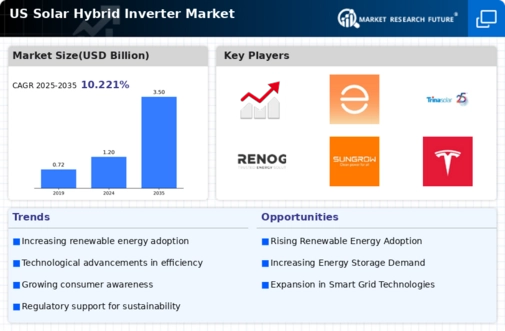Rising Energy Costs
The increasing cost of traditional energy sources is a pivotal driver for the solar hybrid-inverter market. As utility rates continue to rise, consumers and businesses are seeking alternative energy solutions to mitigate expenses. In the US, energy prices have escalated by approximately 15% over the past five years, prompting a shift towards renewable energy sources. Solar hybrid inverters, which allow for the integration of solar energy with grid power, present a cost-effective solution. This trend is likely to accelerate as more individuals recognize the long-term savings associated with solar energy systems. The solar hybrid-inverter market stands to benefit significantly from this economic pressure, as it offers a viable alternative to rising energy costs.
Environmental Regulations
Stringent environmental regulations are increasingly influencing the solar hybrid-inverter market. The US government has implemented various policies aimed at reducing carbon emissions and promoting renewable energy. For instance, the Clean Power Plan aims to cut greenhouse gas emissions from power plants by 32% by 2030. Such regulations create a favorable environment for solar technologies, including hybrid inverters, which facilitate the use of clean energy. As businesses and homeowners strive to comply with these regulations, the demand for solar hybrid inverters is expected to grow. This regulatory landscape not only encourages investment in solar technologies but also enhances the overall market for solar hybrid inverters.
Technological Integration
The integration of advanced technologies into solar hybrid inverters is a significant driver for the market. Innovations such as smart grid technology and energy storage solutions are enhancing the functionality and efficiency of these systems. For example, the incorporation of artificial intelligence in energy management systems allows for optimized energy consumption and storage. This technological evolution is likely to attract more consumers to the solar hybrid-inverter market, as they seek systems that offer greater control and efficiency. The market is projected to grow as these technologies become more accessible and affordable, further driving the adoption of solar hybrid inverters.
Increased Investment in Renewable Energy
Investment in renewable energy is a crucial factor propelling the solar hybrid-inverter market. In recent years, the US has witnessed a surge in funding for solar projects, with investments reaching approximately $20 billion in 2025 alone. This influx of capital is fostering innovation and development within the solar sector, particularly in hybrid inverter technology. As more companies and individuals invest in solar energy, the demand for efficient hybrid inverters is expected to rise. This trend indicates a robust growth trajectory for the solar hybrid-inverter market, as stakeholders recognize the potential returns associated with renewable energy investments.
Consumer Preference for Sustainable Solutions
There is a growing consumer preference for sustainable energy solutions, which is significantly impacting the solar hybrid-inverter market. As awareness of climate change and environmental issues increases, more consumers are opting for renewable energy sources. Surveys indicate that over 70% of US consumers are willing to invest in solar technology to reduce their carbon footprint. This shift in consumer behavior is driving demand for solar hybrid inverters, which provide a sustainable energy solution that combines solar power with traditional grid electricity. The solar hybrid-inverter market is likely to expand as more consumers prioritize sustainability in their energy choices.























Leave a Comment